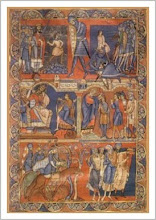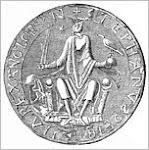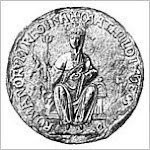• The Heptarchy - The Seven Kingdoms of Anglo-Saxon England
Kent: Home of the Jutes
Kent is reputedly the first Germanic kingdom of the English heptarchy. Following the exodus of the Roman legions what is now Kent grew out of a combination of Jute mercenaries from the continent and native Britons who, at this time, referred to the area as Ceint. The Jutish mercenaries, led by Hengist and Horsa, protected Britain from the Picts and Scots (Irish).
"Take my advice and you will never fear conquest from any man or any people, for my people are strong. I will invite my son and his cousin to fight against the Irish (the Scoti), for they are fine warriors." - Hengist, 5th century.
In the mid fifth century, Hengist married the British king Vortigern's daughter, Rowena, to secure the friendship between the Britons and the Jutes. As a bride gift, Vortigern granted the southeastern kingdom of Ceint to his Hengist and his brother. By the time Vortigern's son, Vortimer, came to power the Jutes were becoming demanding and their relationship with the Britons threatened. Vortimer's army engaged the Jutes in the Battles of Aylesthrep and Creganford, and the British civil war that ensued ultimately led to Kent becoming an entirely Jutish kingdom, and subsequently an Anglo-Saxon one. The Kentish coastline has been known as the Saxon Shore since the third century, and the Isle of Thanet, located on the Saxon Shore, was used by the Jutes as a base of operations.
At the end of the 6th century Pope Gregory send a monk, Augustine, to convert the English to Christianity. He landed in Kent in 597AD and converted King Ethelbert who founded of the See of Canterbury. His daughter (Saint) Ethelburga who died at Lyminge on the 8th September 647AD, was the first queen of Anglo-Saxon race to take the veil. Her relics were stored at the Collegiate Church at Canterbury until the time of the Dissolution of the Monasteries by Henry VIII. Her grave and the ruins of the abbey can be found close to the modern church of St Mary’s and St Ethelburga’s, and a holy well named in her memory can still be seen on the village green.
The capital of Cantwarebyrig, which means 'fortress of the Men of Kent', modern day Canterbury, is located in Eastorege (Eastry), the 'eastern region'.
Kent is densely wooded and the earth is rich in clay, chalk, and coal. Its foremost rivers include the River Medway, which runs westward into the Thames, and the River Stour in the east. Fishing and farming are among Kent's traditional industries. However, while the beer brewing industry has been prominent in Kent and the countryside is dotted with oast houses, the hops/brewing trade has only existed in England since the sixteenth century. Kent is famously known as The Garden of England.
Dover Castle:
Standing proudly above the White Cliffs, Dover Castle as it appears today dates from the rebuilding work during the reign of Henry II 1154-1189 but the site has been of vital importance since the Iron Age. The first castle was probably an Anglo-Saxon fortress and, after the arrival of William the Conqueror, the existing fortifications were improved with the building of an earthwork castle. This Norman motte which supported the castle is today known as 'Castle Hill'. King Stephen 1135-1154, the last of the Norman kings of England, died at Dover Castle and he was interred at Faversham Abbey, also in Kent, alongside his wife, Matilda of Boulogne, and his son Eustace.
• More about Kent:
• Read about Historic Kent
• Check out the website Visit Kent
• View Dover Castle
• Explore a Kent Map
Subscribe to:
Post Comments (Atom)








No comments:
Post a Comment